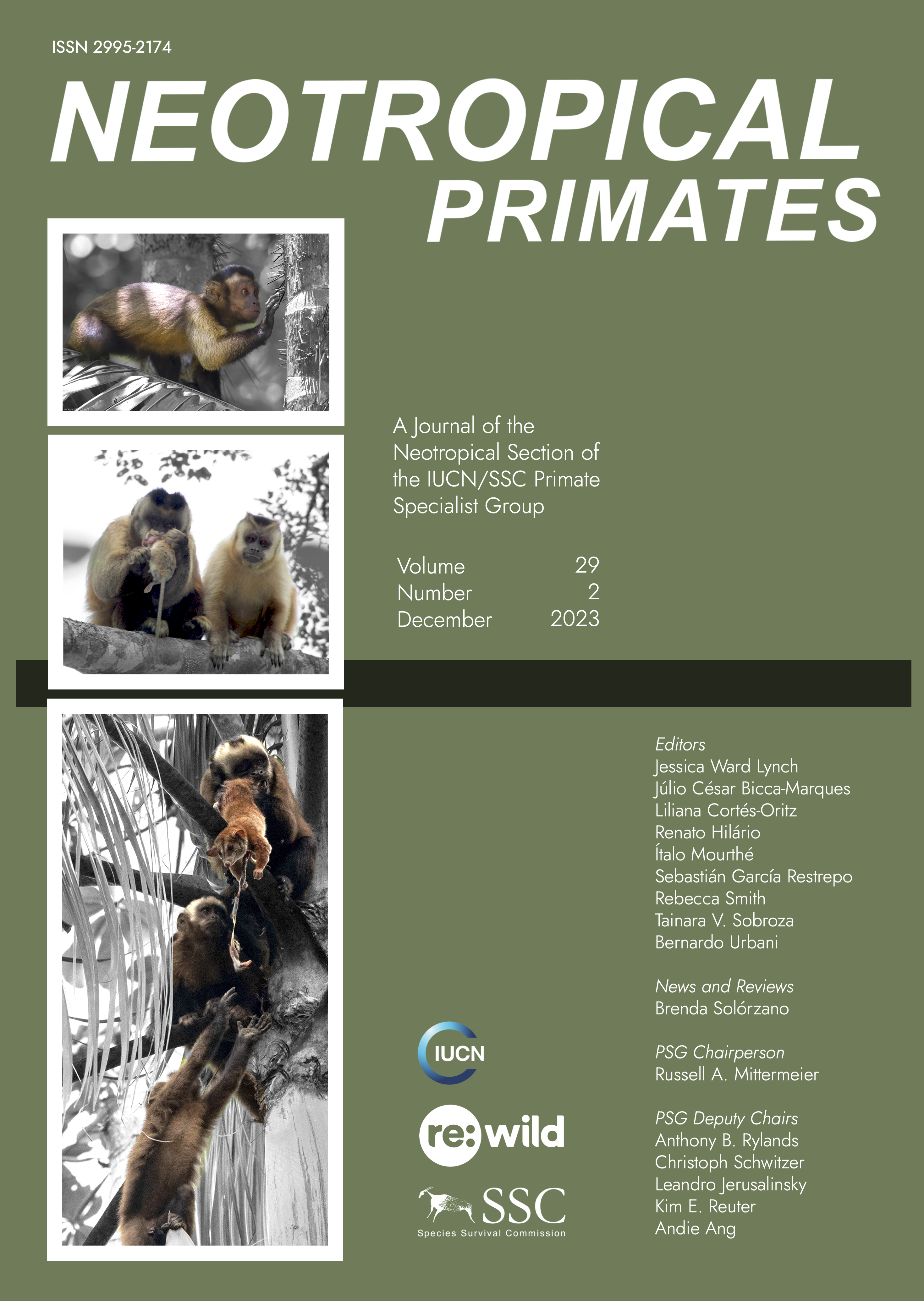Predation attempt by marmosets (Callithrix spp.) on a picazuro pigeon’s nest (Patagioenas picazuro) in an urban environment
DOI:
https://doi.org/10.62015/np.2023.v29.808Keywords:
Callitrichidae, urban primates, invasive primatesAbstract
The introduction of exotic species is one of the greatest threats to biodiversity, with hybridization a major consequence. The species Callithrix jacchus, introduced to the Atlantic Forest, has established populations in urban areas and has been hybridizing with C. penicillata. Its generalist diet includes nest predation on birds, a potential threat to native bird populations. However, much of the data comes from more preserved areas, leaving a gap in our understanding of the impact of these primates on urban bird populations. Here, I describe an attempted predation of eggs in a picazuro pigeon (Patagioenas picazuro) nest by two Callithrix sp. individuals observed in a residential urban area in Campinas, São Paulo, Brazil. During the incident, the animals seemed unbothered by traffic or pedestrians, but were alert to the call of a raptor. While the significant impact of introduced predators on bird populations is well-studied, data on this behavior in invasive primates remains scarce. Further research is needed to better understand the ecological relationships in anthropogenic environments and their impacts on urban biodiversity.
References
Alexandrino, E. R., Luz, D. T. A., Maggiorini, E. V. and Ferraz, K. M. P. M. B. 2012. Nest stolen: the first observation of nest predation by an invasive exotic marmoset (Callithrix penicillata) in an agricultural mosaic. Biota Neotrop. 12: 211–215. https://doi.org/10.1590/S1676-06032012000200021
Braz, A. G., Lorini, M. L. and Vale, M. M. 2019. Climate change is likely to affect the distribution but not parapatry of the Brazilian marmoset monkeys (Callithrix spp.). Divers. Distrib. 25: 536–550. https://doi.org/10.1111/ddi.12872
Cezar, A.M., Pessoa, L. M., Bonvicino, C.R. 2017. Morphological and genetic diversity in Callithrix hybrids in an anthropogenic area in southeastern Brazil (Primates: Cebidae: Callitrichinae). Zoologia 34: 1–9. https://doi.org/10.3897/zoologia.34.e14881
De Miranda, G. H. B. and De Faria, D. S. 2001. Ecological aspects of black-pencilled marmoset (Callithrix penicillata) in the cerradão and dense cerrado of the Brazilian central plateau. Braz. J. Biol. 61: 397–404. https://doi.org/10.1590/S1519-69842001000300008
Ferrari, S. F. et al. 2013. Living on the edge: habitat fragmentation at the interface of the semiarid zone in the Brazilian Northeast. In: Primates in Fragments. Developments in Primatology: Progress and Prospects, L. Marsh and C. Chapman (eds.), pp.121–135. Springer, New York. https://doi.org/10.1007/978-1-4614-8839-2_9
Galetti, M., Bovendorp, R. S., Fadini, R. F., Gussoni, C. O. A., Rodrigues, M., Alvarez, A. D., Guimarães Jr., P. R. and Alves, K. 2009. Hyper abundant mesopredators and bird extinction in an Atlantic Forest island. Zoologia 26: 288–298. https://doi.org/10.1590/S1984-46702009000200011
Goulart, V. D., Teixeira, C. P. and Young, R. J. 2010. Analysis of callouts made in relation to wild urban marmosets (Callithrix penicillata) and their implications for urban species management. Eur. J. Wildl. Res. 56: 641–649. https://doi.org/10.1007/s10344-009-0362-4
Gurevitch, J. and Padilla, D. K. 2004. Are invasive species a major cause of extinctions? Trends Ecol. Evol. 19: 470-474. https://doi.org/10.1016/j.tree.2004.07.005
Lyra-Neves, R. M. D., Oliveira, M. A., Telino-Júnior, W. R. and Santos, E. M. D. 2007. Comportamentos interespecíficos entre Callithrix jacchus (Linnaeus) (Primates, Callitrichidae) e algumas aves de Mata Atlântica, Pernambuco, Brasil. Rev. Braz. Zool. 24: 709-716. https://doi.org/10.1590/S0101-81752007000300022
Malukiewicz, J. 2013. Hybridization and Speciation in Common and Black-tufted Marmosets (Callithrix jacchus and C. penicillata). Doctoral thesis, Arizona State University, Tempe, Arizona, USA.
Marra, P. P. and Santella, C. 2016. Cat Wars: The Devastating Consequences of a Cuddly Killer. Princeton University Press, Princeton. https://doi.org/10.1515/9781400882878
Rylands, A. B., Coimbra-Filho, A. F. and Mittermeier, R. A. 2009. The systematics and distributions of the marmosets (Callithrix, Callibella, Cebuella, and Mico) and callimico (Callimico) (Callitrichidae, Primates). In: The smallest anthropoids: The marmoset/callimico radiation, S. M. Ford, L. M. Porter and L. C. Davis (eds.), pp.25–61. Springer, Boston. https://doi.org/10.1007/978-1-4419-0293-1_2
Silva, M. A. F., Verona, C. E., Conde, M. and Pires, A. S. 2018. Frugivory and potential seed dispersal by the exotic-invasive marmoset Callithrix jacchus (Primates, Callitrichidae) in an urban Atlantic Forest, Rio de Janeiro, Brazil. Mammalia 82: 343–349. https://doi.org/10.1515/mammalia-2016-0075
Warziniack, T., Haight, R. G., Yemshanov, D., Apriesnig, J. L., Holmes, T. P., Countryman, A. M., ... and Haberland, C. 2021. Economics of invasive species. In: Invasive Species in Forests and Rangelands of the United States: A Comprehensive Science Synthesis for the United
States Forest Sector. T. M. Poland, T. Patel-Weynand, D. M. Finch, C. F. Miniat, D. C. Hayes and V. M. Lopez (eds.), pp.305–320. Springer Nature, Cham. https://doi.org/10.1007/978-3-030-45367-1_3
Zaluar, M. T. and Vale, M. M. 2021. Are invasive marmosets harmful to Atlantic Forest birds? Perspect. Ecol. Conserv. 19: 153–160. https://doi.org/10.1016/j.pecon.2021.02.007
Zaluar, M. T., Tardin, R., Llusia, D., Niemeyer, J., Ribeiro, M. C. and Vale, M. M. 2022. Impact of invasive marmosets (Primates, Callitrichidae) on bird acoustic diversity in a large neotropical urban forest. Biol. Invasions 24: 1725–1737. https://doi.org/10.1007/s10530-022-02748-z
Downloads
Published
Issue
Section
License
Copyright (c) 2023 Isabela Viotto Conti

This work is licensed under a Creative Commons Attribution-NonCommercial-ShareAlike 4.0 International License.



